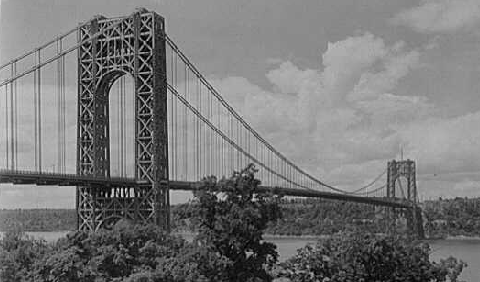We’ve read a lot about the George Washington Bridge in recent weeks. And the scandal over who ordered closure of approach lanes from Ft. Lee NJ only underscores how crucial this bridge is to the entire region. All of which got me thinking about the GWB and its history.
 |
| The Bridge that never was... |
But it was in 1927 that work began on the George Washington Bridge much farther uptown at 179th Street. The $75 million single-level bridge carrying six lanes of traffic opened in 1931 and was widened by two lanes in 1946.
Originally the bridge was going to be called The Bi-State Bridge, The Bridge of Prosperity or The Gate of Paradise (really!), but it was a campaign by school kids that ended up honoring our first President.
The original designers had planned for the future and in 1961 the lower level, six-lane “Martha Washington” bridge opened to traffic, increasing total capacity by 75%.
Because we usually approach the bridge from the east or west, it’s hard to appreciate its enormity until you’re right on the structure. But from any angle it’s a beautiful bridge, showing its bare criss-cross girders and bracing which was originally to have been clad in concrete and granite.
The GWB is recognized by civil engineers and architects alike as one of the most beautiful in the world.
In its first year of operation the bridge carried five million vehicles. Last year it carried 102 million. On opening day the toll was 50 cents each way. Today the one-way toll for autos (only collected eastbound) ranges from $9 (EZ Pass off-peak) to $13 (cash). But pedestrians can still walk across for free (when the sidewalk is open).
Those walkways, while affording a wonderful view of the city, also have a dark side as the GWB was scene of a record 18 suicides (and 43 attempts) in 2012.
 |
| GWB Bus Terminal |
The bridge itself is a living thing. It creaks and groans, moves and sways and it needs constant maintenance. In 2011 the Port Authority announced an eight-year, $1 billion project to replace the bridge’s 529 vertical suspender wire ropes. In addition, lanes on the upper level are being closed (at night) to replace steel plates on the road surface.
All of which means more jobs and, eventually, higher tolls.


No comments:
Post a Comment